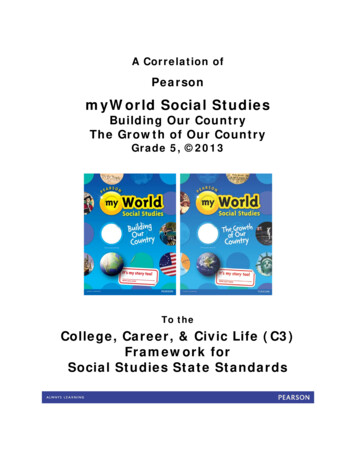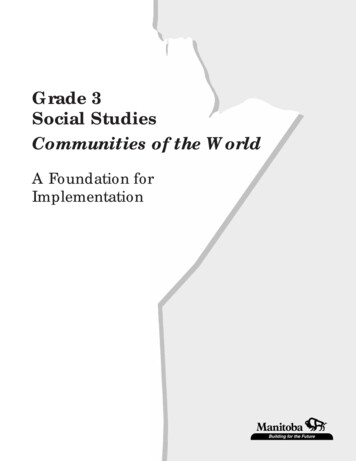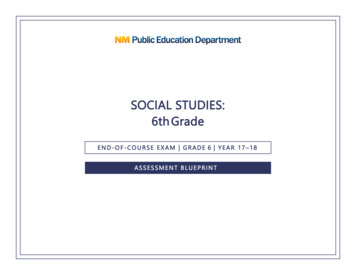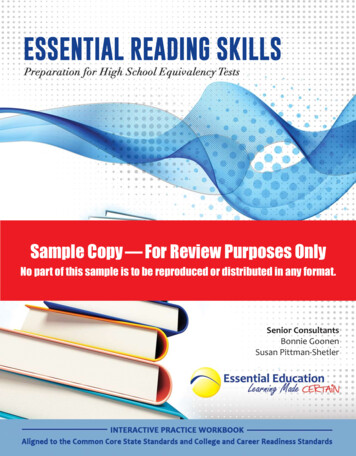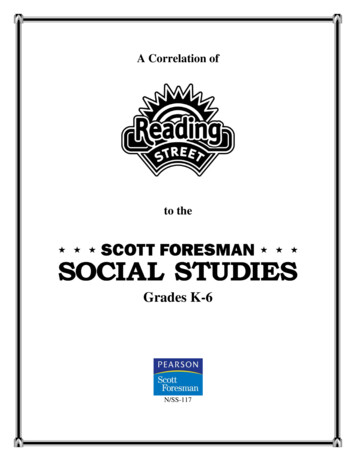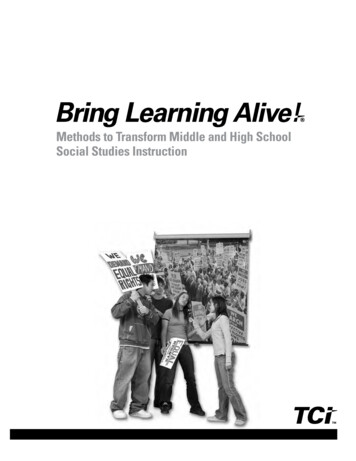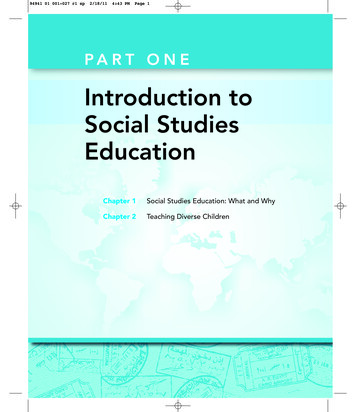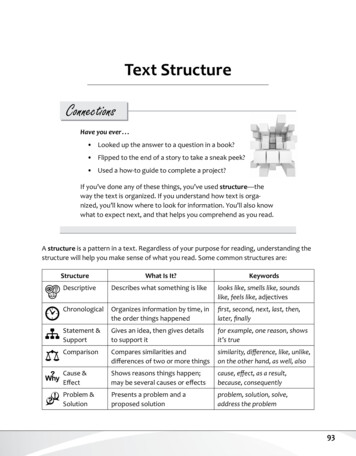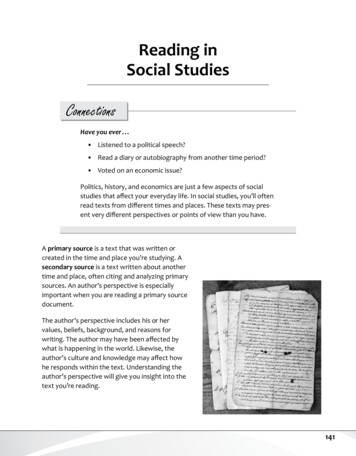
Transcription
Reading inSocial StudiesConnectionsHave you ever . . . Listened to a political speech? Read a diary or autobiography from another time period? Voted on an economic issue?Politics, history, and economics are just a few aspects of socialstudies that affect your everyday life. In social studies, you’ll oftenread texts from different times and places. These texts may present very different perspectives or points of view than you have.A primary source is a text that was written orcreated in the time and place you’re studying. Asecondary source is a text written about anothertime and place, often citing and analyzing primarysources. An author’s perspective is especiallyimportant when you are reading a primary sourcedocument.The author’s perspective includes his or hervalues, beliefs, background, and reasons forwriting. The author may have been affected bywhat is happening in the world. Likewise, theauthor’s culture and knowledge may affect howhe responds within the text. Understanding theauthor’s perspective will give you insight into thetext you’re reading.141
Essential Reading SkillsLearnIt!Determining Author’s PerspectiveAn author’s perspective is a specific viewpoint—a way to think about the topic.It is related to the purpose, and also to the author’s cultural and political background, interests, experiences, and values. You can examine the author’s perspective by looking at the big picture and details.Use this passage for the exercises that follow.The Emancipation ProclamationPresident Abraham Lincoln issued the Emancipation Proclamation onSeptember 22, 1862, as the United States was facing a third year of theCivil War. It was an order as Commander in Chief to the military andexecutive branch. The proclamation declared “that all persons heldas slaves” within the rebellious states “are, and henceforth shall befree.” The following is an excerpt from the proclamation.By the President of the United States of America:A Proclamation.And by virtue of the power, and for the purpose aforesaid, I do order and declarethat all persons held as slaves within said designated States, and parts of States,are, and henceforward shall be free; and that the Executive government of theUnited States, including the military and naval authorities thereof, will recognizeand maintain the freedom of said persons.And I hereby enjoin upon the people so declared to be free to abstain from all violence, unless in necessary self-defence; and I recommend to them that, in all caseswhen allowed, they labor faithfully for reasonable wages.And I further declare and make known, that such persons of suitable condition, willbe received into the armed service of the United States to garrison forts, positions,stations, and other places, and to man vessels of all sorts in said service.This historical passage isfrom a primary source.The introduction is asecondary source.And upon this act, sincerely believed to be an act of justice,warranted by the Constitution, upon military necessity, Iinvoke the considerate judgment of mankind, and the gracious favor of Almighty God.Source: The National Archives, adapted from “The Emancipation eatured documents/emancipation proclamation/142
Reading in Social StudiesBig PictureBefore you read the text, examine your background knowledge. Do you know anythingabout the author or subject matter? What can that tell you about the author’s perspective?Skim the text, making sure to read any context or background information like location andtime period.?1 . Skim the passage and think about your background knowledge. Fill in the Big Picture onthe graphic organizer.Big Picture & DetailsBig Picture: Skim and use your background knowledge to get an overview. What’s the big picture?Details: Look for details to expand and support your ent Abraham Lincoln created this document during the Civil War. It declared all slavesMeaningMeaningin the rebelling southern states free. The word emancipation means the act of freeing. Youmight assume that there are complex political issues behind this document, from keepingthe country united to the moral stance of abolitionists, who strongly opposed slavery.Details: Examine the Author’s Word ChoiceAuthors’ words communicate their perspective. In a conversation, your words show yourfeelings and viewpoint. Authors’ words do the same thing when they write.?2 . Add one word that shows the author’s perspective to the graphic organizer.Big Picture & DetailsBig Picture: Skim and use your background knowledge to get an overview. What’s the big picture?Lincoln is declaring the military should free Southern slavesin the Civil War, may be many political reasonsDetails: Look for details to expand and support your ideas.DetailDetailMeaningMeaningDetailDetailYou might choose the word order or declare because they show Lincoln’s demand to endMeaningMeaningslavery. He is not asking or recommending. He is ordering and declaring that slaves are free.143
Essential Reading SkillsDetails: Examine Facts and ExamplesLocate a detail that shows an author’s perspective, and then find its meaning. What does ittell you about the author?3 . Add a fact, example, or piece of evidence that shows the author’s perspective to thegraphic organizer.Big Picture & DetailsBig Picture: Skim and use your background knowledge to get an overview. What’s the big picture?Lincoln is declaring the military should free Southern slavesin the Civil War, may be many political reasonsDetails: Look for details to expand and support your ideas.declareMeaning state strongly; certain,formalDetailDetailDetailDetailMeaningYou might choose “act of justice” or “gracious favor of Almighty God” as details that showMeaningMeaningLincoln’s values.Determine Author’s PerspectiveYou can make inferences about an author’s beliefs, feelings, and values. Examine the bigpicture and details to define the author’s perspective.Big Picture & DetailsBig Picture: Skim and use your background knowledge to get an overview. What’s the big picture?Lincoln is declaring the military should free Southern slavesin the Civil War, may be many political reasonsDetails: Look for details to expand and support your ideas.?DetaildeclareMeaning state strongly; certain,formalDetailDetailDetailMeaningMeaning"act of justice"Meaning justice is valued, important4 . Review the big picture and details. What can you say about Lincoln’s perspective?The document is a rule issued by the President to set military policy. It’s a strong politicalaction against the South, framing the war as one about slavery. Lincoln also refers to justice,the Constitution, human kindness, and God. As a reader, you can infer that these are valuesthat influenced the document.144
ReadingLessonin SocialTitleStudieseicPractIt!The following passage is from the majority opinion on Brown v. Board of Education, a U.S. Supreme Court case that resulted in the desegregation of publicschools in 1952. A majority opinion explains the reasons for the ruling agreed onby the majority of justices.Use this passage to answer the questions that follow.OpinionMR. CHIEF JUSTICE WARREN delivered the opinion of the Court . . .We come then to the question presented: Does segregation of children in public schools solely on the basis of race, even though thephysical facilities and other “tangible” factors may be equal, deprivethe children of the minority group of equal educational opportunities? We believe that it does.In Sweatt v. Painter, supra, in finding that a segregated law schoolfor Negroes could not provide them equal educational opportunities, this Court relied in large part on “those qualities which are incapable of objective measurement but which make for greatness in alaw school.” In McLaurin v. Oklahoma State Regents, supra, the Court, in requiring that a Negro admitted to a white graduate school be treated like all otherstudents, again resorted to intangible considerations: “. . . his ability to study, toengage in discussions and exchange views with other students, and, in general,to learn his profession.” Such considerations apply with added force to children ingrade and high schools. To separate them from others of similar age and qualifications solely because of their race generates a feeling of inferiority as to their statusin the community that may affect their hearts and minds in a way unlikely ever tobe undone. . . .We conclude that, in the field of public education, the doctrine of “separate butequal” has no place. Separate educational facilities are inherently unequal. Therefore, we hold that the plaintiffs and others similarly situated for whom the actionshave been brought are, by reason of the segregation complained of, deprived ofthe equal protection of the laws guaranteed by the Fourteenth Amendment. This disposition makes unnecessaryThis historical passageany discussion whether such segregation also violatesis from a primarythe Due Process Clause of the Fourteenth Amendment.source—a text writtenduring a historical periodbeing studied.Source: Brown v. Board of Education, 347 U.S. 483 (1954) (USSC ), available atThe National Center for Public Policy Research, http://www.nationalcenter.org/brown.html145
Essential Reading Skills1 . Complete the graphic organizer with the big picture and details about theauthor’s perspective.Big Picture & DetailsBig Picture: Skim and use your background knowledge to get an overview. What’s the big picture?Details: Look for details to expand and support your gMeaning2 . Describe Chief Justice Warren’s perspective as the author of this decision.3 . What is the reason Warren gives to overturn “separate but equal” in education?a . Separate schools are impossible to maintain.b . Separate schools don’t provide equal education.c . Separate schools are too costly and unnecessary.d . Separate schools have tangible equal factors.4 . Chief Justice Warren writes, “To separate them from others of similar age and qualifications solely because of their race generates a feeling of inferiority as to their statusin the community that may affect their hearts and minds in a way unlikely ever to beundone.” What does this quote show that Chief Justice Warren values?a . Special treatment of minority racesb . Government regulationc . Children’s psychological well-beingd . Religious freedom146
Reading in Social StudiesThe following passage is from Susan B. Anthony’s 1873 speech after she was arrested, tried,and fined 100 for voting in the 1872 Presidential Election.Read the passage and answer the questions that follow.Friends and Fellow Citizens: I stand before you tonight underindictment for the alleged crime of having voted at the lastpresidential election, without having a lawful right to vote.It shall be my work this evening to prove to you that in thusvoting, I not only committed no crime, but, instead, simplyexercised my citizen’s rights, guaranteed to me and all UnitedStates citizens by the National Constitution, beyond thepower of any State to deny.The preamble of the Federal Constitution says:“We, the people of the United States, in order to form a moreperfect union, establish justice, insure domestic tranquility, provide for the common defense, promote the general welfare, and secure the blessings of libertyto ourselves and our posterity, do ordain and establish this Constitution for theUnited States of America.”It was we, the people; not we, the white male citizens; nor yet we, the male citizens; but we, the whole people, who formed the Union. And we formed it, not togive the blessings of liberty, but to secure them; not to the half of ourselves andthe half of our posterity, but to the whole people—women as well as men. Andit is a downright mockery to talk to women of their enjoyment of the blessings ofliberty while they are denied the use of the only means of securing them providedby this democratic-republican government—the ballot.For any State to make sex a qualification that must ever result in the disfranchisement of one entire half of the people is to pass a bill of attainder, or an ex postfacto law, and is therefore a violation of the supreme law of the land. By it theblessings of liberty are for ever withheld from women and their female posterity.To them this government has no just powers derived from the consent of the governed. To them this government is not a democracy. It is not a republic. It is an odious aristocracy; a hateful oligarchy of sex; the most hateful aristocracy ever established on the face of the globe; an oligarchy of wealth, where the right govern thepoor. An oligarchy of learning, where the educated govern the ignorant, or evenan oligarchy of race, where the Saxon rules the African, might be endured; but this147
Essential Reading Skillsoligarchy of sex, which makes father, brothers, husband, sons, the oligarchs overthe mother and sisters, the wife and daughters of every household—which ordainsall men sovereigns, all women subjects, carries dissension,discord and rebellion into every home of the nation.This historical passage isfrom a primary source.Source: “Is it a Crime for a Citizen of the United States to Vote?” by Susan B. Anthony,available at ony/anthonyaddress.html5 . Describe Susan B. Anthony’s perspective.6 . Select and explain two powerful details that show Anthony’s beliefs, feelings, or values.7 . What does Anthony mean when she says, “To them this government has no just powersderived from the consent of the governed”?8 . Imagine you are researching women’s fight for the right to vote. How might you use theinformation in this passage?148
Reading in Social StudiesCheck Your SkillsRead the passage and answer the questions that follow.The following is an excerpt from the first Fireside Chat with former President Franklin Delano Roosevelt on March 12, 1933. It was given after the nation’s banks closed to stop masswithdrawals by people worried about bank failures.I want to talk for a few minutes with the people of the United Statesabout banking—with the comparatively few who understand themechanics of banking but more particularly with the overwhelmingmajority who use banks for the making of deposits and the drawingof checks. I want to tell you what has been done in the last few days,why it was done, and what the next steps are going to be. I recognizethat the many proclamations from State capitals and from Washington, the legislation, the Treasury regulations, etc., couched for themost part in banking and legal terms, should be explained for thebenefit of the average citizen. I owe this in particular because of thefortitude and good temper with which everybody has accepted the inconvenienceand hardships of the banking holiday. I know that when you understand what wein Washington have been about I shall continue to have your cooperation as fullyas I have had your sympathy and help during the past week. . . .Because of undermined confidence on the part of the public, there was a generalrush by a large portion of our population to turn bank deposits into currency orgold—a rush so great that the soundest banks could not get enough currency tomeet the demand. The reason for this was that on the spur of the moment it was,of course, impossible to sell perfectly sound assets of a bank and convert theminto cash except at panic prices far below their real value. . . .This historical passage isfrom a primary source.It was then that I issued the proclamation providingfor the nationwide bank holiday, and this was thefirst step in the Government’s reconstruction of ourfinancial and economic fabric.Source: President Franklin Delano Roosevelt, First Fireside Chat, available at: http://historymatters.gmu.edu/d/5199/149
Essential Reading Skills1 . Which of the following describes President Roosevelt’s message in the passage?a . President Roosevelt is explaining why the banks have closed.b . President Roosevelt is giving a lesson on banking to the people.c . President Roosevelt is blaming the people for the failure of the banks.d . President Roosevelt is angry at the banks for closing.2 . Why does President Roosevelt thank the listeners for their strength and patience?a . He is paying an underhanded compliment to his opponents.b . He is being sarcastic and pointing out the harm of panicking.c . He wants the listeners to accept future bank closures.d . He wants the listeners to be supportive of his policies.3 . Who is the main audience President Roosevelt is speaking to in this Fireside Chat?a . The American peopleb . The banking industryc . President Roosevelt’s friends and familyd . The world4 . What is President Roosevelt’s purpose for speaking?a . To explain banking to the publicb . To calm the public’s fears about the bank failurec . To entertain with stories about the Great Depressiond . To deceive the public into taking his side5 . Which best describes President Roosevelt’s interest in thebanking failure?a . He thinks the banks deserve to fail because of the downfall of the economy.b . He wants to protect the people from the knowledge thatmore banks could fail.c . He wants to bail the banks out with government money.d . He wants to work with the banks to reconstructthe economy.150Rememberthe ConceptThe author’sperspective can helpyou understand howto read a text and howthe author’s values,background, and biasescan affect a text.
Answers and ExplanationsReading in Social Studiespage 141Determining Author’s PerspectivePractice It!pages 145–1481.Big Picture & DetailsBig Picture: Skim and use your background knowledge to get an overview. What’s the big picture?The Supreme Court ruled to desegregate schools becausesegregation negatively impacts the education of children.Details: Look for details to expand and support your ideas.Sense of inferior statusMeaning Segregation make minoritiesfeel others look down on them.DetailDetailDetailDetail"separate but equal" has no placeMeaningEducation cannot beseparate & equallifelong inner woundsMeaning Problems from segregationlast a lifetime."hearts and minds"Meaning Shows court's empathy forstudents2. Chief Justice Warren has reviewed examples where students were negatively impactedby segregation. He has determined that, legally and emotionally, segregation deprivesstudents of equal educational opportunities. He believes that segregation itself makesstudents feel unequally valued and separates them emotionally from the community.3. b. Separate schools don’t provide equal education.4. c. Children’s psychological well-being5. Susan B. Anthony sees voting as her right as a United States citizen. She sees womenas being equal to men and included in the Constitution through the phrase “We, thepeople.” She believes that any country that would not recognize a woman’s vote is nota democracy.6. Example 1: “I not only committed no crime, but, instead, simply exercised my citizen’srights, guaranteed to me and all United States citizens by the National Constitution,beyond the power of any State to deny.” With these words, Anthony claims that her decision to vote is justified by the U.S. Constitution because it refers to “We, the people,”not just “the white male citizens.”Example 2: “And it is a downright mockery to talk to women of their enjoyment of theblessings of liberty while they are denied the use of the only means of securing themprovided by this democratic-republican government—the ballot.” Anthony stronglyrejects the idea that liberty can be separated from the ballot, the right to vote. She usesthe word mockery, which shows her strong emotion.i
Essential Reading Skills7. Anthony is stating that to women, the government’s powers are unjustified becausewomen have no representation in the government. Without the right to vote, womencannot be justly ruled over by a government.8. You might use the information in this passage to learn more about the Americanwomen’s rights movement and the core beliefs and arguments of its leaders.Check Your Skills1. a. President Roosevelt is explaining why the banks have closed.2. d. He wants the listeners to be supportive of his policies.3. a. The American people4. b. To calm the public’s fears about the bank failure5. d. He wants to work with the banks to reconstruct the economy.iipages 149–150
Reading in Social Studies The following passage is from the majority opinion on Brown v. Board of Edu-cation, a U.S. Supreme Court case that resulted in the desegregation of public schools in 1952. A majority opinion explains the reasons for the ruling agreed on by the majority of justices. Use this passage
